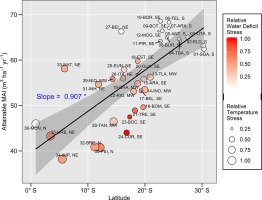Ecological Indicators ( IF 7.0 ) Pub Date : 2020-03-31 , DOI: 10.1016/j.ecolind.2020.106325 Elvis Felipe Elli , Paulo Cesar Sentelhas , Neil Huth , Rafaela Lorenzato Carneiro , Clayton Alcarde Alvares

|
Managing climatic variability is essential for dealing with current genotype x environment interactions and for adapting Eucalyptus plantations to future climate change. This study uses a process-based modelling approach to assess long-term effects of spatial and temporal climate variability on Eucalyptus productivity for 36 sites across Brazil. The attainable stem wood mean annual increment (MAI, m3 ha−1 yr−1) was simulated by the APSIM Next Generation Eucalyptus model, considering three soil types (clay, sandy-clay and sandy-loam) and twenty-seven rotations of seven years, using weather data from 1980 to 2013. Spatial and temporal (inter-annual and inter-seasonal) climate variability strongly affected Eucalyptus MAI across Brazilian regions. Average Eucalyptus MAI ranged from 38 m3 ha−1 yr−1 (Imperatriz, MA, Northeast region) to 69 m3 ha−1 yr−1 (Borebi, SP, Southeast region), while its coefficient of variation ranged from 3.2% (Antônio Olinto, PR, South region) to 17.2% (Bocaiúva, MG, Southeast region). Our results suggest an average increment of about 0.91 m3 ha−1 yr−1 for each increase of one degree in latitude. Eucalyptus growth was mostly driven by water deficit combined with high temperatures at tropical sites, while the tree growth was more affected by low winter temperatures at subtropical sites. The results of the present study have value for understanding how Eucalyptus plantations change their growth in response to changing climate. Gauging the effects of climate variability on Eucalyptus growth may assist in forest planning by estimating the area to be cultivated, machinery sizing, climate risk, and guiding the tree breeders in choosing appropriate genotypes.
中文翻译:

评估气候变化对巴西桉树人工林生产力的影响:基于过程的建模方法
管理气候变异性对于处理当前的基因型x环境相互作用以及使桉树人工林适应未来的气候变化至关重要。这项研究使用基于过程的建模方法来评估巴西36个地点的时空气候变化对桉树生产力的长期影响。APSIM下一代桉树模拟了可获得的茎木平均年增量(MAI,m 3 ha -1 yr -1)该模型使用1980年至2013年的天气数据,考虑了三种土壤类型(黏土,沙土和砂壤土)和27年的七次轮作。使用时空(年际和季节间)气候变异性巴西各地区的桉树MAI。桉树的平均MAI为38 m 3 ha -1 yr -1(Imperatriz,MA,东北地区)至69 m 3 ha -1 yr -1(Borebi,SP,东南地区),而其变异系数为3.2% (南部地区的宾利奥林托(AntônioOlinto))至17.2%(东南部的博卡伊瓦(MG)我们的结果表明平均增加量约为0.91 m 3公顷-1 yr -1每增加1度纬度。桉树的生长主要是由缺水和热带地区的高温共同驱动的,而树木的生长则受到亚热带地区冬季气温较低的影响。本研究的结果对于了解桉树人工林如何响应气候变化而改变其生长具有价值。评估气候变化对桉树生长的影响可能会通过估计要耕种的面积,机器的大小,气候风险以及指导树木育种者选择合适的基因型来协助森林规划。











































 京公网安备 11010802027423号
京公网安备 11010802027423号